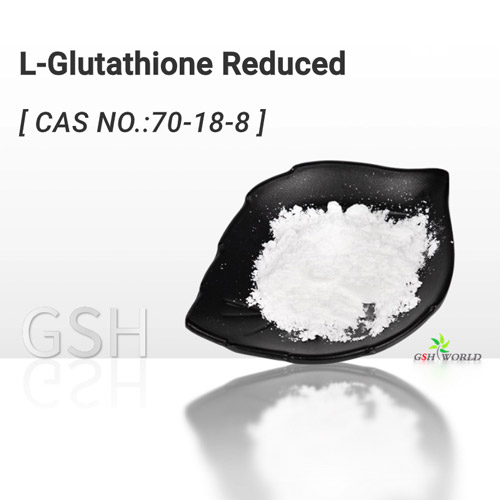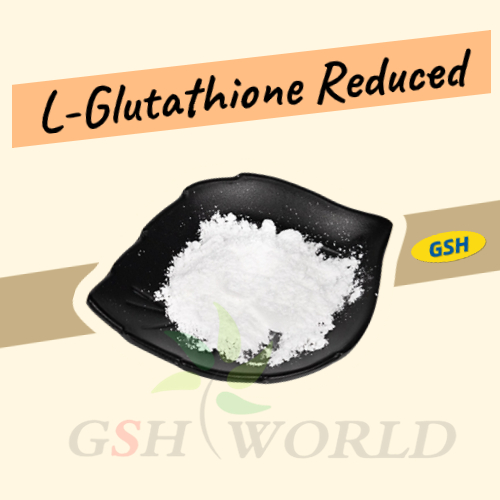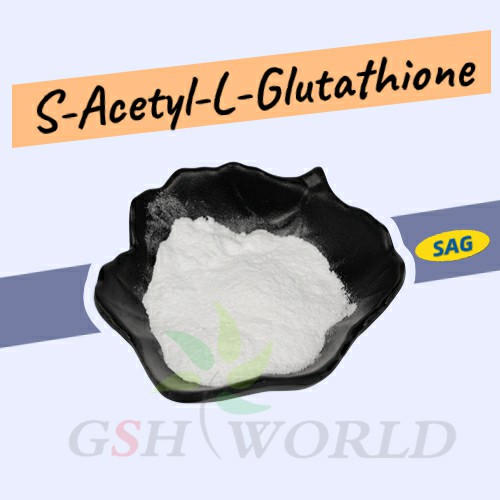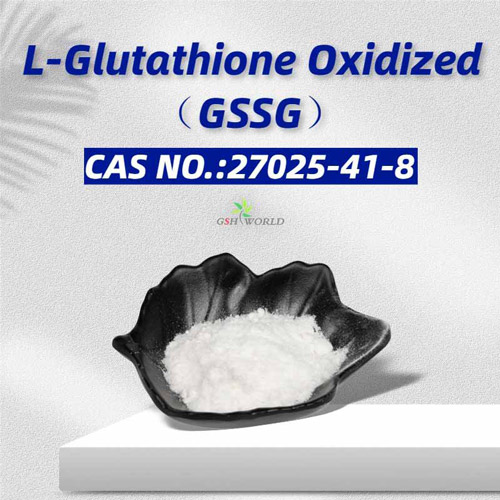Glutathione product introduction
Glutathione is a tripeptide containing gamma-peptide bonds and sulfhydryl groups, composed of glutamic acid, cysteine and glycine, widely found in plants, animals and microorganisms, is one of the most important non-protein sulfhydryl compounds in living organisms, under physiological conditions, glutathione mainly in the form of reduced glutathione (GSH) and oxidized glutathione (GSSG) exist in two forms. Active reduced glutathione accounts for about 90%, and oxidized glutathione can be reduced to reduced glutathione by GSH reductase and consume NADPH, so GSH described below refers to reduced glutathione.
Glutathione basic information do you understand?
Glutathione is composed of glutamic acid, cysteine and glycine through peptide bonds, and there is a special gamma-peptide bond in the molecule, that is, the peptide bond formed by condensation of gamma-COOh of glutamic acid and α-NH2 of cysteine.

It is different from ordinary peptide bonds in protein molecules. Glutathione is a white crystal, soluble in water, low concentration ethanol solutions, liquid ammonia and dimethylformamide.

How bad is glutathione?
Glutathione is generally divided into four grades, of which the most clinically used is pharmaceutical grade GSH for injection.
| rank | Standard | remark |
| Food grade | National standards for food safety | Defined ion |
| Cosmetic grade | Intra-enterprise standard | Defined ion |
| Pharmaceutical grade | Pharmacopoeia 2020, USP43, EP9.0 | Defined impurity content |
| Health grade | Intra-enterprise standard | Bacterial colony |
Glutathione molecule contains γ-glutamyl group and active sulfhydryl group, which is the structural basis of many important physiological functions of GSH.
1. Antioxidant
Glutathione is a natural reducing agent in the body, which is easy to be oxidized to GSSG, so as to protect other substances from oxidation, can remove free radicals in the body, such as hydrogen peroxide, peroxide free radicals, etc., protect the sulfhydryl group in the protein from oxidation, repair the sulfhydryl group in the destroyed protein, so that the protein can restore the active function, prevent cell hemolysis. Promote the reduction of methemoglobin, and relieve the discomfort caused by hypoxemia, nausea and liver disease.
2. Detoxify
Glutathione can detoxify carcinogens such as carbon monoxide, CO, heavy metals, organic solvents and epoxides, and can be combined with them and excreted in vitro.
It has a protective effect on leukopenia caused by radiation, radiopharmaceutical or antitumor drugs.
It also detoxifies various carcinogens by helping liver metabolism, such as aflatoxin.
Reduced glutathione for injection
- Chemotherapy patients;
- Radiotherapy patients;
- Various hypoxemia;
- Liver disease;
- Can also used for the auxiliary treatment of organophosphorus, amine or nitro compound poisoning;
- Antidote drug toxicity;
3. Prevention and treatment
Glutathione can used to protect the liver, promote liver detoxification, often used in the treatment of alcoholism, cirrhosis, hepatitis, fatty liver and other liver diseases, long-term use of GSH can inhibit the formation of alcoholic fatty liver.
GSH also contributes to the maintenance of corneal and lens transparency and tissue repair and regeneration, and can also used to treat progressive cataracts, corneal diseases and retinal diseases.
Glutathione also plays an important role in diabetic vasculopathy, and GSH has used in the treatment of diabetic neuropathy, diabetic nephropathy, diabetic fatty liver and other complications.
GSH can also assist lymphocyte donor recovery, inhibit viral replication, AIDS adjuvant treatment drugs;
Glutathione for injection can also used to reduce reactive oxygen species produced during dopamine metabolism in the substantia nigra region of the midbrain to alleviate neurodegenerative diseases, such as the remission of early Parkinson’s disease.
Glutathione in the application of life
1. Food ingredient

Glutathione widely used in the food field and can added to yogurt and baby food as a stabilizer.
It can also added to food, fish and seafood foods to inhibit nucleic acid decomposition;
Add to pasta to reduce bread mixing time.
2. Cosmetics ingredient

GSH can prevent the penetration of Los tyrosinase, thus achieving the purpose of inhibiting melanin formation.
It can eliminate wrinkles, increase skin elasticity, shrink pores, dilute pigment, and has excellent whitening effect on the human body.
GSH has been popular for decades as a major ingredient in cosmetics in Europe and the United States.
Does glutathione really fight aging?
In 2017, a double-blind control group clinical trial conducted abroad.
The intervention group divided into a reduced glutathione group supplemented with 250mg per day and a oxidized glutathione group with the same dose.
After the trial period of 12 weeks, it found that both reduced glutathione and oxidized glutathione could improve the skin status of the intervention group.
All subjects had reduced UV-induced dark spots, and some subjects had reduced skin wrinkles and increased skin elasticity after glutathione supplementation.

How to supplement glutathione more effective?
GSH an important antioxidant in the body, which constantly depleted by stress, poor diet, aging, and toxic substances in the environment.
Although the diet can supplement glutathione, but the role of eating them, like supplements, the human body will decompose, bioavailability is small.
A double-blind control clinical study published in 2015 noted that the effect of oral GSH is not only proportional to the time of supplementation, but also that the effect may take longer to produce.
Many experiments have proved that oral GSH, if it is a common dosage form, is less efficient, requires a larger dose and a longer time, but it will also have an effect. If a more easily absorbed dosage form used, the absorption and effect are better.
How is glutathione produced?
In 1888, French scientist Rey-Pailhade discovered GSH in yeast and named it “philothion”.
In 1921, Hopkins discovered that it was self-oxidizing and contained glutamic acid and cysteine, and renamed it GSH.
With the development of crystalline technology, GSH identified in 1929 as a tripeptide composed of glutamic acid, cysteine and glycine.
The chemical structure of GSH determined, but its practical application hampered by the high price of glutathione due to the limitation of raw materials.
In 1935, Hanington et al. synthesized GSH by chemical methods, and the optimized chemical synthesis method realized the commercialization of GSH, and Mesister realized the production of glutathione by enzyme catalysis or fermentation.
In the early 1980s, countries such as Japan first began fermentation to produce GSH.
At present, the main preparation methods of glutathione are: chemical synthesis, biological fermentation and enzymatic method.
Glutathione synthesized by chemical synthesis, because the active product is not easy to separate, need chemical resolution, product purity is not high, difficult to promote.
The process of biological fermentation is relatively mature, but the production cycle is long, the yield is low, and too many by-products make the downstream process complicated, and it has begun to gradually lag behind.
In recent years, the technology of enzymatic production of GSH has gradually improved, and large-scale production has gradually begun.
Enzymatic method also divided into traditional method and new method. The traditional method has high cost of ATP, while the new method realizes ATP regeneration with low cost and less pollution.

Enzymatic production of glutathione technology advantages
- The reaction speed is fast, and the production cycle is short: the enzymatic reaction completed within 1 day, and the fermentation method is at least 5 days, and the period cannot interrupted
- Low energy consumption, low cost: ATP renewable, less time, energy, raw materials and labor costs are low
- Green and environmental protection, in line with national development requirements: truly achieve zero addition of heavy metals and toxic gases (except crystallization process using alcohol), sewage treatment is superior to fermentation, and it is an unadulterated green process
- High yield, easy purification: the yield of enzymatic reaction 30~50g/L, the maximum yield of fermentation about 10g/L; Enzymatic reaction component determined, easy to purify; The composition of fermentation products complex and toxic substances need to used for purification
Glutathione market prospects
In recent years, the world’s growing population, aging population, global climate change and other issues have made global pharmaceutical consumption maintain a stable growth trend.
With the continuous improvement of people’s living standards, people increasingly concerned about health issues, and the proportion of medical care in daily consumption expenditure has significantly increased.
The world will gradually enter an aging society, the deepening of the reform of the world medical and health system and the continuous expansion of medical insurance coverage, the pharmaceutical industry will experience a long-term development process.
Now the problem is solved! It’s solved!
A brand from China, GSHWORLD, its glutathione raw material, 10 years after listing, because of good reputation and sold to 56 countries and regions, the use of more than 120 million people, many scientists, stars, athletes have become a super fan of this product, the changes after use posted on a variety of social media, without spending a penny advertising costs, A good product depends on its results.
GSHWORLD’s core products



Bulk L-Glutathione Reduced Powder, Bulk S-Acetyl-L-Glutathione Powder, Bulk L-Glutathione Oxidized Powder
GSHWORLD’s patented breakthrough technology solves the problem of GSH absorption rate to the greatest extent, can improve immunity, focus, help detoxify the liver, reduce cellular inflammation, lighten spots, anti-wrinkle, whiten, shrink pores, etc.



